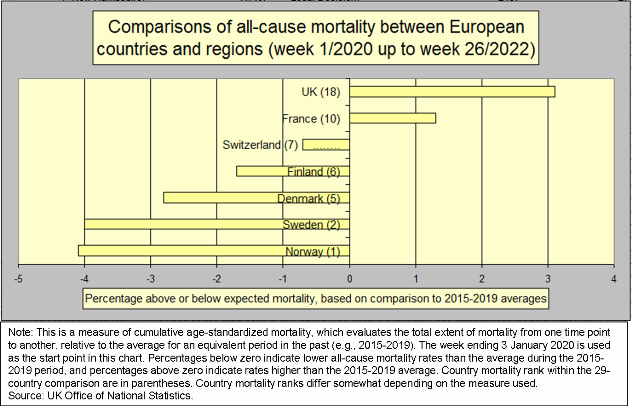“During the COVID-19 pandemic, Sweden was among the few countries that did not enforce strict lockdown measures but instead relied more on voluntary and sustainable mitigation recommendations. While supported by the majority of Swedes, this approach faced rapid and continuous criticism. Unfortunately, the respectful debate centered around scientific evidence often gave way to mudslinging. However, the available data on excess all-cause mortality rates indicate that Sweden experienced fewer deaths per population unit during the pandemic (2020–2022) than most high-income countries and was comparable to neighboring Nordic countries through the pandemic. An open, objective scientific dialogue is essential for learning and preparing for future outbreaks.”
- The Swedish COVID-19 approach: a scientific dialogue on mitigation policies, Björkman et al, 2023
Sweden actually had a lower all-cause death rate during the pandemic than the 2015-2019 average and was virtually tied with Norway for the lowest rate in Europe, relative to the pre-pandemic years.
Of course plenty of Swedes died of Covid during the pandemic - especially during the first half of 2020 - but total all-cause mortality was lower than the pre-pandemic period. That’s because fewer Swedes died of causes other than Covid, such as accidents, and the mortality rate for those under 60 was lower than during the pre-pandemic period. The vast majority of Swedes who did die of Covid were 60 and older, per this chart from Statista:
Per the above numbers, just 1.5% of Swedes who have died of Covid so far have been younger than 50, compared to 96% of those 60 and older. What these numbers tell me was that Sweden was right to forego broad preventative measures during the Covid pandemic and to focus instead on mitigating risk for its most vulnerable residents, namely frail elders and individuals with comorbidities.
The lesson here is not that broad preventative measures don’t work in a pandemic. Broad measures might very well be appropriate when the disease is broadly debilitating or fatal.
The message is don’t be so quick to criticize and condemn when you’re in dark yourself, which entails recognizing the flimsy foundation of what feels like the truth.
References:
Björkman A, Gisslén M, Gullberg M, Ludvigsson J. The Swedish COVID-19 approach: a scientific dialogue on mitigation policies. Front Public Health. 2023 Jul 20; 11:1206732. doi: 10.3389/fpubh.2023.1206732. .
Juul FE, Jodal HC, Barua I, Refsum E, Olsvik Ø, Helsingen LM, Løberg M, Bretthauer M, Kalager M, Emilsson L. Mortality in Norway and Sweden during the COVID-19 pandemic. Scand J Public Health. 2022 Feb;50(1):38-45. doi: 10.1177/14034948211047137. Epub 2021 Oct 5. PMID: 34609261; PMCID: PMC8807990.
Office for National Statistics (ONS) and Government Office for Science (GOScience), published 20 December 2022, ONS website, article, Comparing Different International Methods of Measuring Excess Mortality

